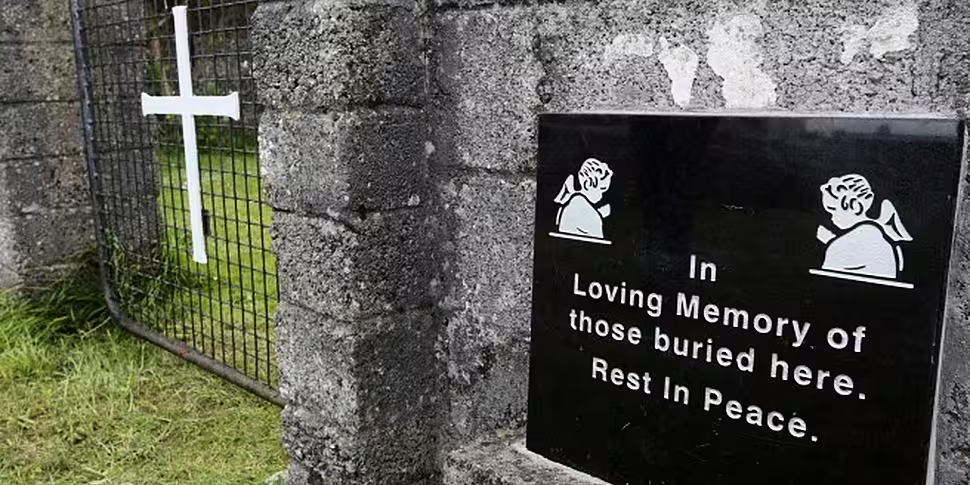A new report on the former site of the Mother and Baby Home in Tuam, Co Galway has said individual identification of remains found there is unlikely without "significant investigation."
The Children's Minister Katherine Zappone has published the Expert Technical Group Report on the site.
She says public consultation will inform decisions on the future of the site.
Earlier this year, the Mother and Baby Homes Commission of Investigation (MBHCOI) identified human remains in 17 out of 20 chambers discovered in an elongated structure within the boundaries of what is currently referred to as the memorial garden.
This report identified the number of deaths from the General Registers Office of 796 children during the years 1925-1961.
But the technical report warns: "Individual identification of remains here is unlikely without further significant investigation.
"The commingled state of individuals makes it particularly challenging to isolate the skeletal remains of a single individual.
"The risk of destruction to human remains themselves, in the pursuit of DNA, also poses a range of ethical questions.
"In a collective interment scenario, a collective identity is potentially all that is possible."
The report also identifies five possible options for managing the site and responding to the discovery of infant remains there.
The department says the options are being explored and presented "in the context of internationally accepted best practice."
- Memorialisation: an option that may be adopted in its own right but also as a result of any further option or action undertaken on site.
- Exhumation of known human remains: whereby human remains are exhumed to an alternative location with no further investigation or analysis.
- Forensic excavation and recovery of known human remains: a full forensic control and methodology to recover the remains identified to date by previous excavations. Engineering and Health and Safety consultations indicate that excavation here would be possible but will require a considered approach and significant ground preparations. Full analysis of the remains could be conducted at a post excavation stage.
- Forensic excavation and recovery of known human remains with further evaluation/excavation of other areas of interest: the geophysical survey conducted over the entire site illustrates that there are further subsurface anomalies outside of the memorial garden. This would include the recovery of remains identified in the memorial garden and any further human remains identified at other locations.
- Forensic excavation of total available area: the most intrusive excavation covering 100% of the available site. All known human remains would be recovered and all other anomalies would be investigated. This is the most exhaustive approach with potential to expose archaeological features.
The report includes detailed geophysical and engineering surveys undertaken.
The report will now be shared and Galway County Council will facilitate a consultation process, with a strong focus around Tuam.
Following its consideration at a Government meeting, Minister Zappone said: "I commissioned this report to give us a fuller understanding of the options that might be available, and to ensure that the outcomes which might be realistic and attainable in respect of each course of action could be understood by the public.
"I want to thank the members of the Expert Technical Group, led by Niamh McCullagh, for their work on such a complex and sensitive issue.
"Their excellent report adds considerably to our knowledge on these matters and will help everyone involved to better understand the nature of the options now open to us."
Minister Zappone adds: "This process will be designed to provide all interested parties with an opportunity to have their say and contribute to the decisions which must be made in respect of the site."
Further details on the consultation process will be announced shortly by Galway County Council.
DNA testing
The report makes key points in relation to the potential use of DNA testing in Tuam.
This includes, what it calls, "the impossibility" of achieving positive DNA identification of infants and young juveniles without samples from living relatives.
"Even then, identification will be extremely difficult, and will depend on the quality of the remains recovered", it says.
It also says the quality of samples are less likely to be usable for DNA identification in the case of infants because the best source of DNA can be teeth, including the root, which are not sufficiently formed in humans until the age of two years.
It also points out that the process of DNA testing can itself destroy the samples, leaving little left to re-inter after the process.
"While this may be acceptable when dealing with e.g. whole skeletons or significant intact portions, it is far less satisfactory when being used to identify individual fragments of commingled remains which are effectively destroyed as they are 'individualised'".
It also says there is the need for a pilot/feasibility study before any decision is taken to move to a larger programme of DNA testing.
But it says that even then, the pilot/samples would give an indication of results only for the selected sample - rather than for the wider site.
Read the report in full here









